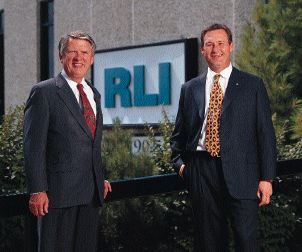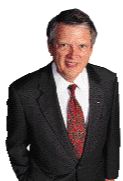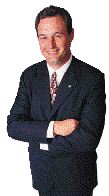

Gerald D. Stephens, president of RLI Corp. (left) and Jonathan E. Michael, president of RLI Insurance Company.
When Gerald D. Stephens founded RLI Corp. in 1961, he was fresh out of college and working in his father's insurance agency in Peoria, Illinois. It occurred to him that there might be a market for insuring consumers against the loss of contact lenses, a product that was just in its infancy.
"At that time, it cost around $200 to replace a pair of lenses, and most of the people who wore them were young and couldn't afford to take that risk," Stephens notes.
While still with the agency, Stephens formed RLI Insurance Company--so named to stand for Replacement Lens Insurance. The company eventually captured 85% of the insurance market for replacement contact lenses. Gradually, prices of the lenses fell dramatically, and that insurance market dwindled. But by then RLI was a profitable specialty insurer with a broader product line, listed on the New York Stock Exchange, and doing business in all 50 states.
"The initials of the company constantly remind me that nothing is forever," says Stephens, who now is president of RLI Corp. "If we had continued to write only contact lens insurance, we'd be out of business today."
Aside from learning that markets can come and go, the contact lens experience also provided key disciplines that RLI uses in all the markets it has subsequently entered. "We continue to be very product focused and specialized," says Stephens.
The contact lens experience also taught RLI not to be afraid of markets that other insurers either haven't thought of or have chosen to avoid. Thus, RLI has created comfortable niches for itself selling stand-alone personal umbrella coverage, California earthquake insurance and homeowners in Hawaii. It also writes more traditional commercial property, casualty and surety business.
The financial results have been impressive. Sales of RLI Corporation, which includes RLI Insurance Company and its surplus lines subsidiary, Mt. Hawley Insurance Company, reached more than $300 million in 1997. In the 1997 annual report, Stephens says RLI is "on our way to a $1 billion company."
Profitability, the ultimate measuring stick, has been even more impressive. Its combined ratio has been over 100 only four times in its 37-year history. The company has posted record earnings for 11 consecutive quarters, and last year Moody's ranked RLI 177th in dividend growth among 10,000 U.S. public companies.
 "Our inviolate code is not to write business just to gain market share. A risk must meet our standards for making a profit."
"Our inviolate code is not to write business just to gain market share. A risk must meet our standards for making a profit."
--Gerald D. Stephens
While most insurers avoid catastrophe exposures like the plague, RLI's leading line of business is difference in conditions (DIC)--commercial coverage for earthquake, flood and mudslide. California is the primary market for this business, and RLI has been there since the early '80s.
"Other companies avoid DIC because it might upset their quarterly earnings," says Stephens. "We love it because, for us, it is extremely profitable." The keys to profitability, he says, are talented employees, state-of-the-art tools--including being at the forefront of using earthquake simulation tools, Internet-based systems and expert underwriting systems.
However, Stephens stresses, "You can't look at any one year's results to measure profitability." The company has been through the Loma Prieta quake in 1989 (broadcast live during the World Series) and, five years later, the more serious Northridge quake. The latter event caused RLI to post after-tax losses of more than $40 million for 1994 and 1995.
"We've never been in a line of business where we didn't understand the risks," says Stephens. "We've proven that we're a stable market even after these major events. We've gone through three major earthquakes now and we were the first company back on the street offering protection to insureds after the events occurred."
Two years ago RLI entered the homeowners market in Hawaii, another state where many property insurers fear to tread. It did so by purchasing the residential property business of the Hawaii Property Insurance Association (HPIA). The HPIA was originally set up to insure volcanic ash exposures, but after Hurricane Iniki hit the islands in 1992, residential property business was forced into HPIA as the regular market constricted.
"This specialty book of homeowners business requires an expertise in CAT exposures, which we have," says Jonathan E. Michael, RLI Insurance Company president. With its purchase of the HPIA business, RLI now derives 7% of its total premiums from Hawaii homeowners.
 RLI established a new transportation division a year ago. "We expect to do $18 million to $20 million of transportation business this year."
RLI established a new transportation division a year ago. "We expect to do $18 million to $20 million of transportation business this year."
--Jonathan E. Michael
The move also gives RLI a strong presence among hundreds of independent agents in Hawaii, with whom RLI writes the business directly. This could become increasingly important to RLI as, just two months ago, it added auto insurance to its Hawaii product mix.
Herbert Nishida, president of Occidental Underwriters of Honolulu, which is now writing homeowners with RLI, says the transfer of business from the HPIA has been a smooth one. "After Hurricane Iniki, it wasn't all bad business that got put into the HPIA. There were good risks that were in there just because insurers had pulled out of the market. We never forgot that the HPIA had helped us when we needed it, so when the market softened, we didn't want to pull business away from them. RLI has made it very easy to switch the business to them."
RLI's enthusiasm for this business is obvious, Nishida says. "Bruce Anderson, who heads up their Hawaii homeowners operations, personally comes to our office to deliver commission checks." And, adds Nishida, "It could be helpful to be able to place RLI's umbrella, auto and homeowners together."
Mike Krosevic, a senior account executive with Insurance Associates, Inc., a $15 million premium firm in Honolulu, agrees that having a complete personal lines program will be useful. "By writing the homeowners coverage with them, we get a 5% discount on the umbrella, and their auto rates are very competitive."
Krosevic's agency is one of hundreds of agencies throughout the country that write RLI's stand-alone personal umbrella insurance through a program offered to members of the Independent Insurance Agents of America. The company began the program in the late '80s. Other agents can gain access to RLI's stand-alone umbrella program through a few large agencies which serve as administrators.
"The personal umbrella policy is typical of our thinking in product development," says Stephens. "Most companies won't write it without the underlying coverages. It is difficult to offer it on a stand-alone basis because you need the same underwriting information you do for the auto policy. By developing a highly automated process we were able to do it."
The majority of RLI's total book of business is written in the specialty market, accessible to agents through wholesale brokers. This includes the DIC and other commercial property business, and, on the casualty side, primary liability, umbrella and excess, D&O and employers liability. RLI has developed a sizeable book of surety business expected to exceed $30 million by year-end 1998. This includes miscellaneous and small contract business done through special surety agents.
"They get quotes out and policies out quicker than other companies," says Steve Conner, president of Crump Insurance of Texas, a Dallas-based wholesaler. Crump does business with retail agents throughout Texas and contiguous states, and uses RLI for property, general liability and umbrella business. "They give us excellent service on the risks that agents can't place in their standard markets," says Conner.
Jim Barnes, CEO of Sherwood Insurance Services in San Francisco, the fourth largest wholesaler in the U.S., has written business, much of it catastrophe-type coverages, with RLI for 20 years. "RLI has weathered the storms in this market," says Sherwood. "They've always been there for us."
Barnes characterizes RLI as "innovators." Other wholesalers we spoke with used similar terms--"ahead of the curve," "on the cutting edge"--to describe RLI. How has this company, born out of an insurance agency in the quintessential middle-of-the-road city of Peoria, Illinois, maintained this reputation long after its original market of contact lenses has gone away?
Part of the answer lies in the careful process RLI follows once it decides to enter a new market. "We spend a lot of time finding the right employees to run a new operation," says Stephens. This was critical, he says, when the company decided to enter the highly competitive transportation insurance market a year ago by setting up an office in Atlanta.
Michael explains that process. "We began by hiring two individuals--Dave Dunn and Ward Stein--who each have more than 20 years' experience in the transportation business. They follow our philosophy--underwriting for a profit, focusing on the customer, treating the agents right, and bringing technology to the transaction. With their contacts in the industry they've been able to hit the ground running with us, and we expect to do $18 million to $20 million of transportation business this year."
About the same time it was setting up its transportation division, RLI took a similarly careful approach to entering the surety business. "We searched for four years to find the kind of talent we were looking for to get into this market," says Stephens. "Finally we were able to hire Dave Sandoz, who had been vice president of surety for Western Surety. He started our surety business from scratch and its growth has been outstanding.
"One of the keys to our growth in miscellaneous surety process has been automation," Stephens continues. "Some agents don't like to handle this business because of the small premiums and paperwork, but with our automated process, the reception by agents has been phenomenal. It goes back to our beginnings as a company. We were used to handling $15 contact lens premiums, so a $60 premium looks like a lot of money."
This year RLI expanded its presence in the professional liability market, and again its approach was to hire an industry professional. Quentin Orza, who came from Chubb where he had been manager of worldwide D&O liability underwriting, has established a new professional liability office for RLI in New York City.
"We've done $15 million to $20 million in the professional liability market for the past several years," says Stephens. "Looking down the road, we need to get it to the $100 million level. Much of the professional liability business we have written has come through the alphabet house brokers, but now it is moving more to the smaller retail agents."
RLI employees at all levels have more than their paychecks as their financial stake in the company's future. In 1972 the company established an Employee Stock Ownership Program (ESOP), and today approximately 12% of the company shares are in the hands of employees through the ESOP. Each year if the company meets predetermined profit goals, a further contribution is made to the employees' accounts.
So far, it has gone very well. RLI has paid 15% of wages into the employees' ESOP accounts every year except the one following the Northridge earthquake. "Both our nonemployee shareholders and our employee shareholders are on the same team," says Stephens.
RLI is proud of its consistent record of profitability. The four years when its combined ratio has exceeded 100 were the result of unusual circumstances--once in the early '70s when the switch to soft contact lenses resulted in higher losses, once due to uncollectible reinsurance and the two years following the Northridge earthquake. "Our inviolate code is not to write business just to gain market share," says Stephens. "A risk must meet our standards for making a profit."
Having started out at H.O. Stephens and Son Insurance Agency in Peoria, which his father founded in 1929, Jerry still follows the agency business closely. He eventually sold the family agency to its former manager, Jim Hardesty, who "has done a good job with it."
"I have great respect for independent insurance agents," Stephens says. The feeling must be mutual since, Stephens notes, "A lot of agents have stock in RLI." *
©COPYRIGHT: The Rough Notes Magazine, 1998